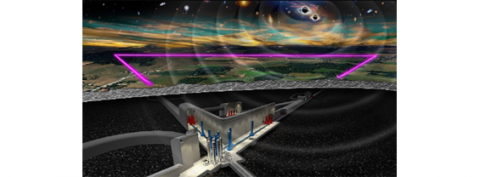The Einstein Telescope adopted in the ESFRI 2021 Roadmap

One of the adopted proposal is the Einstein Telescope, the first and most advanced third-generation gravitational-wave observatory, with unprecedented sensitivity that will put Europe at the forefront of the Gravitation Waves research.
ET builds on the success of current, second-generation laser-interferometric detectors Advanced Virgo and Advanced LIGO, whose breakthrough discoveries of merging black holes and neutron stars over the past 6 years have ushered scientists into the new era of gravitational-wave astronomy. The ET will achieve a greatly improved sensitivity by increasing the size of the interferometer from the 3km arm length of the Virgo detector to 10km, and by implementing a series of new technologies. These include a cryogenic system to cool some of the main optics to 10 – 20K, new quantum technologies to reduce the fluctuations of the light, and a set of infrastructural and active noise-mitigation measures to reduce environmental perturbations.
The ET will make it possible, for the first time, to explore the Universe through gravitational waves along its cosmic history up to the cosmological dark ages, shedding light on open questions of fundamental physics and cosmology. It will probe the physics near black-hole horizons (from tests of general relativity to quantum gravity), help understanding the nature of dark matter (such as primordial black holes, axion clouds, dark matter accreting on compact objects), and the nature of dark energy and possible modifications of general relativity at cosmological scales. Exploiting the ET sensitivity and frequency band, the entire population of stellar and intermediate mass black holes will be accessible over the entire history of the Universe, enabling to understand their origin (stellar versus primordial), evolution, and demography. ET will observe the neutron-star inspiral phase and the onset of tidal effects with high signal-to-noise ratio providing an unprecedented insight into the interior structure of neutron stars and probing fundamental properties of matter in a completely unexplored regime (QCD at ultra-high densities and possible exotic states of matter). The excellent sensitivity extending to kilohertz frequencies will also allow us to probe details of the merger and post-merger phase. ET will operate together with a new innovative generation of electromagnetic observatories covering the band from radio to gamma rays (such as the Square Kilometer Array, the Vera Rubin Observatory, E-ELT, Athena, CTA).
Our Sapienza University is at the front end of the Einstein Telescope project both on the experimental and on the theoretical forefronts. The Department of Physics and the Department of Civil Engineering are contributing significantly on the defining Science case, instrumental set-up and infrastructure design. The GW experimental group at Sapienza is working on the design and on the development of the experiment, in particular on the site characterisation at Sos Enattos, in Sardinia (one of the candidate sites for the experiment, site selection expected for 2024). The gravity theory group is involved in the coordination of the Fundamental Physics Division in the ET Observational Science Board.
